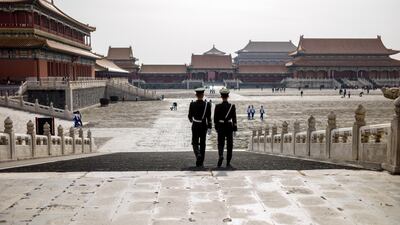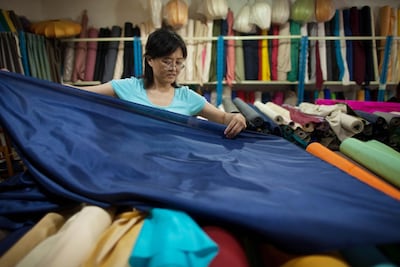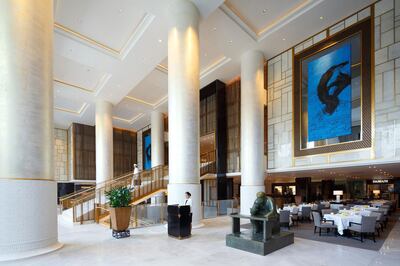Beijing isn't a city to visit purely to shop. But there's much to see here, and now is the time to go. Bitterly cold in winter, boiling hot in summer, it's at its best in April or May, September or October. Appropriately for the capital of the world's most populous country, it's massive, home to 21 million of China's 1.4 billion people, and although for decades the authorities have been busy with the bulldozers, replacing lovely old areas with tower blocks and eight-lane highways, enough has survived to make the capital an essential destination for any traveller.
From the stretches of the Great Wall lying a 45-minute drive outside the city, via old palaces, museums and art centres, to the massive Tiananmen Square in the heart of Beijing that was built by Mao, principal architect of Communist China, so that a million workers could file in there to cheer him, and the 15th-century Forbidden City, home of the emperors, that Tiananmen leads into, there’s easily enough to fill a week – with some serendipitous buys along the way sweetening the stay.
China isn't cheap, though, to visit or to shop. The latter can come as a surprise, given how much of the world's merchandise is manufactured here, from eight out of 10 smartphones to almost 45 per cent of the world's clothing and 60 per cent of its shoes. But the tax that Chinese authorities impose on the price of any foreign-branded items sold in China mean you will pay around 15 to 20 per cent more in China for almost any western brand.
In the giant Apple store in Beijing's APM mall, for instance, on Wangfujing Street, the main shopping area, the iPhone X, made in China, costs 9,688 yuan (Dh5,621). No bargain at all. And although you don't have to go to China to find plenty of cheap stuff on Alibaba, the country's equivalent of Amazon, even inexpensive made-in-China items aren't that inexpensive these days. Thanks to China's yuan appreciating more than 30 per cent in the past few years, plus rising labour costs, even made-in-China gel pens, for example, that a few years ago cost Dh1.25 or less, are now a less wondrous Dh5.75 or so.
Then there is the big issue of fakes. Fake watches and designer bags may have once been quite a thrill, but these days, when authenticity is all, who wants anything but the real thing? In recent years, China's authorities have announced crackdowns on the massive fake industry as part of their anti-corruption measures, and certainly I noticed that far fewer young women now carry the formerly ubiquitous "Louis Vuitton", or possibly actual Louis Vuitton, handbags. But is that a reflection of a change of fashion or the crackdown?
It's wise to shop with a sceptical eye, and perhaps to leave Beijing's smartest boutiques, in the chic little mall below The Peninsula hotel, to the local princelings. "Beijing is full of rich young things, the children of Party officials", a French expat working there tells me. "A few years ago, they became wary about looking too conspicuously wealthy, but now they don't seem to mind again. Or care what they spend." As he speaks, two 20-something men walk past, one sporting a massively logo'd Dsquared² bomber jacket, the other showing off an equally ludicrously large Loewe logo.
While shopping is now so high-tech in Beijing that most Chinese people now buy everything using their mobile phone, from designer bags to a mooncake from a street-carts, one thing that still feels unnerving is how sales assistants will shadow you around a store, sometimes standing literally inches behind you. It may feel like an anti-shoplifting measure (thanks, guys), but it's actually to ensure they get the commission on anything you buy. I have to endure an assistant shadowing me for half an hour, sighing audibly, as I browse the museum section of the Tea Culture shop, shooting me poisonous looks when I paid her back by sailing out, smiling sweetly to annoy her, without spending a single yuan.
As with most places, the best buys turn out to be the local specialities.
The main shopping areas: Wangfujing Street, Sanlitun and Dazhalan Street
Along with the north-easterly neighbourhood of Sanlitun – an international quarter and nightlife and shopping area of soaring steel and glass where retailers ranging from Lanvin to Uniqlo and the excellent Bookworm bookshop (beijingbookworm.com) – Dazhalan Street and Wangfujing Street, in Dongcheng Central, are the areas of most interest to visitors keen to browse and shop. They are still surrounded by evidence of old Beijing: hutongs, the charming alleys of courtyard houses that the city's authorities seem so mysteriously keen to destroy, and side streets where old restaurants still have traditional red lanterns inside and red flags outside.
Broad and pedestrianised, Wangfujing Street is lined with luxury malls and department stores, with a Mandarin Oriental hotel opening later this year, and has the Dengshikou Line 5 subway station a five-minute walk away. Come at 7am and you can watch open-air dancing and exercises; come at night (the shops are all open from 10am to 10pm, seven days a week) and it’s fun to stroll around, looking in the Oriental Plaza mall and Beijing Department Store, the old Shengxifu Hat Shop, and getting rid of spare change in the numerous sweet shops.
Mostly made of soya bean paste mixed with glucose syrup, sandwiched between rice-paper or turned into squidgy little lozenges, Chinese sweets are no good for you, but are so prettily packaged that a bowlful on a coffee table or brought out after dinner looks novel and appealing. About Dh20 buys a 300-gram bagful, with 20 or more varieties to choose from. Take care to avoid the chicken feet in tempura that also get displayed on sweet counters.
Dazhalan Street is home to some of the city's oldest fabric shops, some cool cafes and, best of all, the Daguanlou Cinema, which opened in 1903 and by some miracle has escaped the continual razing of old Beijing. Tickets, astonishingly, cost about Dh1.75. Also worth browsing: the Baitasi design district (btsremade.com) in a redeveloped historic hutong area, and Gulou, the area surrounding the 600-year-old Drum and Bell Towers that once marked the city's entrance. Wherever you go, stay away from the electronics malls. Prices aren't great and non-locals are seen as suitable targets for faulty stock.
Buying silk
Silk is one of the genuinely great buys in China. The real thing, that is. Viscose can look and feel astonishingly similar. The most reliable test is to rub two pieces of fabric together between your fingers. Silk produces a sound like crunching through snow, whereas viscose produces no sound. If you don’t have time to shop for silk in the city, the duty-free area at the airport is home to Cathay House. The long silk patterned dressing gown I bought here wasn’t an amazing bargain, at Dh1,160, but it’s definitely the real thing and really beautiful, on sale with silk pyjamas for Dh455, men’s silk dressing gowns embroidered with a massive dragon on the back at Dh2,320 and silk scarves from Dh70 to Dh520.
To buy silk by the metre, it's worth visiting one of the huge fabric stores on Wangfujing, where brocade furnishing silk – Dh70 a metre for heavy, good quality – was a top buy at the Silk & Cotton Shop. As ever, you need to look sceptical and bargain.
The best silk buy of all is arguably a silk duvet: a hypoallergenic, habotai-silk-covered, mulberry-silk-floss-filled duvet. Much lighter and less puffily bulky than feather-down or synthetically-filled duvets, these drape neatly over the bed, are great for hot climates – although rather than a 2.5 tog, you might need a 7.5 or even 12 tog if you sleep in fierce air conditioning – and wrap around you slinkily and cosily. Embarrassingly, I bought mine where most guidebooks warn everyone not to go: the New Silk Alley Market, infamous for its fakes.
Entered from the street or Yonganli subway station (use exit A1), this is seven floors of small shops, with shoes and boots and bags on one floor, electronics on another, and so on. You can't look at anything without being accosted by a salesperson, but their aggressive persistence softens if you remain smiling, jokey and relaxed, and perhaps use the stall-owner's own techniques to bargain. "I know it will break your heart but I am going to offer a special price just for you" or "You look very clever, so I know you know I will go to another stall if you don't accept my price" makes them laugh, as does offering something ridiculous when they shove a calculator at you and demand you type in your best price: "500,000,000 yuan. My final price."
For a medium-weight, 7.5-tog, double duvet, I was initially quoted Dh2,500 by one trader, Dh1,800 by another, but the Dh230 I eventually paid seemed very reasonable. Especially given that it would cost at least US$350 (Dh1,286) outside China, and that an apparently identically stitched and filled duvet at the Beijing Department Store, where prices are fixed, was on sale at Dh1,075. Time could prove me wrong, but I think I got a bargain.
Tea
China is the home of tea, growing bushes long before tea was introduced to India or Sri Lanka, and it's still routinely drunk here, as it has been for thousands of years, despite the arrival of coffee via Starbucks (where a flat white, if you're interested, costs Dh19 to Dh22). Next to the Waldorf Astoria hotel, near Wangfujing Street, the Ten Fu Tea Culture shop (tenfu.com), leading outlet of 1,000 stores across China, is well worth visiting, not least for its museum. Motion-sensitive miniature machines showing the tea-processing procedure whizz into action as you approach and evocative old prints show tea being drunk in tea houses on snowy hillsides in 17th-century China. Teas are all free to sample – a popular oolong ginseng costs Dh93 for 50g. But be warned: you will be approached as soon as you enter by a sales assistant who will then dog your steps until you leave the shop – smiling if you have bought something, scowling ungraciously if you haven't. Also recommended: Teajoy Market on Maliandao Road; Zhang Yi Yuan on Dashilan Street; and Wuyutai Tea Shop on Wangfujing Street.
______________________
Read more:
Destination China: visa-free travel from the UAE to these six cities and beyond
Hotel Insider: The Peninsula Beijing
Bigger and better in Beijing, China
______________________
Glasses
If you wear glasses, take your prescription with you. Glasses – sunglasses, frames alone or frames plus prescription lenses – are a genuine bargain here. Most brands have their frames manufactured in China, and frames that cost Dh1,100-plus at home will cost anything from Dh40 to Dh585 here for a top designer name. It helps if you have the model name and number of the style you want. But be careful about lenses. Chinese-made lenses are generally not as fine and precise as Japanese or Korean ones, so if you can't get to a store selling those, it is best to have your prescription filled at home, and buy just the frames in Beijing.
Stores such as the Bao Dao and Optical Glasses chains are reliable and have fixed prices. There are branches next door to each other just around the corner from Ten Fu Tea Culture, and my varifocals for Dh585 seem a good buy at a quarter of what I would pay at home. Or if you enjoy bargaining, try Zhaojia Glasses City, on Huawai Beili, Dongsanhuan Nanlu, not far from the Panjiayuan market, a 15-minute walk from Jinsong Station. This has five floors of stalls, all selling glasses and sunglasses.
Open-air markets, cosmetics and traditional Chinese medicine
Locals in search of puffer jackets, jeans or trainers for less than $10 (Dh37) flock to the massive indoor Dongwuyuan or Beijing Zoo series of market halls, opposite the Beijing Exhibition Centre. But for visitors, the most interesting market is the open-air Panjiayuan, open on Saturday and Sunday, in south Beijing, near the Panliayuan subway station. It sells arts and crafts, antiques, enamelware, Cultural Revolution kitsch, Mao posters, chopstick sets and assorted knick-knacks. For cosmetic items – Chinese women prize a pale, poreless-looking complexion – the removal of consumption tax on non-luxury cosmetics and skincare in 2016 means it's worth stocking up on items such as skin-cleansing/buffing sponges at Dh5 or Dh6 in pharmacies and neighbourhood supermarkets.
Near Tiananmen Square, Liulichang Street is famous for its antique shops, but because it's forbidden to take genuine antiques out of China, it's safer to look for interesting junk. Anyone who uses traditional Chinese medicine will find all the remedies a good buy. China produces most of the world's crops of ginseng, and whether you buy a whole root or ginseng pills or tea, you will find prices are vastly lower than outside the country. For 60g of top-quality ginseng in capsule form, you pay Dh130. The Beijing Yong An Tang Pharmacy has a branch on Wangfujing Street.
Chinese contemporary art
The Chinese art scene has grown explosively in the last decade, with Chinese buyers major players at auction houses around the world and hundreds of galleries opening in the capital. But to see and buy the work of contemporary Chinese artists, such as Gao Xiaowu or Peng Wei, and find alluring modern takes on the traditional Chinese art of shard pottery – pots studded with shards of broken pots – the best place to visit is the 798 Art Zone, in the north-east of the city, in a Mao-era, East German-built, Bauhaus-style former factory complex now operating as an arts village housing local artists, along with outposts of international galleries, multimedia performance spaces decorated with posters of Mao from the 1960s and 1970s Cultural Revolution, a great bookshop, cafes and restaurants. It’s a good place to hang out for an afternoon or evening, especially during the art festivals that run in April/May and October.
Museum shops
Having a guide take you around museums and sights such as the Forbidden City is essential, for the information as well as the ironic commentary they offer. ("The Ming dynasty was a centralised dictatorship. The government like Ming. The Song dynasty was about leaders respecting intellectuals. The government doesn't like the Song dynasty," one guide says dryly. Bespoke-beijing.com have the best.) The Forbidden City – built after 1421, when the third Ming emperor made Beijing the capital once again, and where the emperors appear to have lived in a permanent state of paranoia, sleeping in bedrooms laid with rice paper so they could hear anyone approach – has 20 gift shops dotted throughout its vast grounds, which are good sources of presents such as mouse pads, iPhone covers, scarves, porcelain vases and tea sets, all imprinted with ancient imperial designs. But the best of the gift shops is at the city's main museum, the National Museum of China, which with its 48 massive halls emerged from its 2010 makeover and merger with the National Museum of Chinese Revolution to become the largest museum in the world. Its porcelain tea sets make a pleasing buy at Dh200.
Getting around
Taxis are cheap – about $4 (Dh15) a journey, maximum – but their drivers are unhelpful and the traffic is terrible. The subway system couldn't be more efficient, however. Beijing is massive, so the 17 lines don't reach into every corner, but you don't actually want to go into every corner: this is fundamentally an ugly new city of streetfuls of high-rise worker flats split by six-lane highways, with little or nothing of interest outside a few central areas. With ticket machines offering instructions in English, clear, colour-coded overhead station signage also in English, and each platform displaying its trains' route just as clearly, you will get the hang of the system in minutes. Fares cost less than Dh2.50.
Where to stay
The Peninsula (beijing.peninsula.com) is in Dongcheng Central, the centre of the city's luxury shopping zone. It was originally named The Palace and became Beijing's first international five-star hotel when it was launched in 1986, when China's Communist authorities were first opening up the country to the world. Renovation in 2016 transformed it from shabby to chic, with acres of pale marble floors, 230 well-thought-out suites with Frette linen, excellent blackout blinds, large and gleaming marble bathrooms with a control panel by the bath operating the TV and spa music channel, and other little details that will be familiar to anyone who has come to prize Peninsula above most other luxury hotel chains.
Its farm-to-table restaurant Jing sources most produce from 17 little organic farms outside the city; the carved-wood walls and antique lanterns of the Huang Ting restaurant are wonderfully atmospheric (although the menu is Cantonese); and the spa, which is dark, fragrant and oriented to traditional Chinese medicine, has therapists who will work hard to dekink muscles or soothe any cases of shopper's foot with reflexology. Double rooms cost from Dh995, including taxes.
Getting there
Emirates (emirates.com) and Etihad (etihad.com) both fly from the UAE to Beijing, from Dh2,665, including taxes








